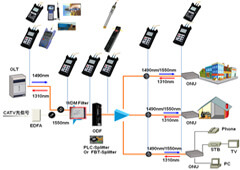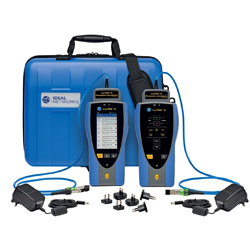A Comprehensive Guide to Optical Measurement System for Fiber Analysis
When it comes to fiber evaluation, understanding optical dimension systems is vital for assessing efficiency and making sure top quality. You'll check out crucial techniques like interferometry and spectroscopy, which aid you determine vital specifications. There's even more to it than simply these techniques; mastering depletion dimension methods can significantly influence your network's effectiveness. As you navigate through this overview, you'll uncover insights that could change your approach to fiber optics.
Comprehending Optical Measurement Solutions
When you discover optical measurement systems, you'll uncover they're vital for assessing fibers with accuracy. These systems make use of light to examine different features of fibers, including size, refractive index, and uniformity. By utilizing techniques like interferometry and spectroscopy, you can gain useful insights right into the fiber's properties.You'll locate that these systems are created to decrease errors and boost accuracy, ensuring dependable data for your analysis. Different setups, such as single-mode and multi-mode systems, accommodate details fiber kinds, allowing you to pick the ideal suitable for your needs.Moreover, the integration of advanced software application tools aids you interpret the information effectively, making it less complicated to identify any incongruities or problems. As you examine much deeper right into these measurement systems, you'll appreciate how they improve the analytical procedure and boost the overall high quality of fiber production and testing.
Key Parameters for Fiber Analysis
Secret specifications for fiber evaluation play a crucial role in determining the top quality and performance of optical fibers. When you review a fiber, you'll intend to concentrate on characteristics such as attenuation, transmission capacity, and modal dispersion. Attenuation determines the loss of signal toughness as light travels through the fiber. A lower depletion worth indicates far better quality and longer transmission distances - fibre testing equipment.Bandwidth describes the data-carrying ability of the fiber and is important for high-speed interaction. You'll need to evaluate the bandwidth to guarantee it fulfills your application requirements. Modal diffusion, which develops from the various speeds at which light trips via various modes in multimode fibers, impacts signal quality
Strategies for Depletion Measurement

Transmission capacity and Its Effect on Efficiency
Comprehending transmission capacity is essential for enhancing fiber efficiency, as it straight influences the amount of information that can be transmitted over a network. Greater transmission capacity implies you can send even more details all at once, permitting faster interaction and much better overall performance. When you're dealing with fiber optics, it's important to take right into account how data transfer communicates with fiber characteristics, such as core size and material properties.If the bandwidth is limited, you may experience data loss or slower rates, impacting your applications. Furthermore, various types of fibers can sustain varying data transfer levels, so it's essential to pick the best fiber for your certain needs.You need to also keep in mind that environmental elements, like temperature level and exterior disturbance, can influence data transfer. By understanding these elements, you can make informed decisions to improve your fiber optic systems, making certain trustworthy and reliable information transmission.
Refractive Index Measurement Techniques

Complete Interior Representation
Complete inner representation (TIR) works as an essential concept for gauging the refractive index of fibers. When light travels from a denser tool to a less dense one, it can just be totally mirrored if the angle of occurrence goes beyond a particular threshold, called the crucial angle. This sensation permits you to determine the refractive index by evaluating the angles at which light mirrors or refracts. By utilizing a configuration that routes light into a fiber and gauges the resulting angles, you can compute the refractive index accurately. Understanding TIR not only boosts your fiber evaluation yet additionally boosts the style and efficiency of optical systems. So, leveraging TIR can result in more reliable fiber-based applications.
Interferometric Methods
Structure on the principles of overall inner representation, interferometric methods give a powerful methods for determining the refractive index of fibers with high precision. These approaches exploit the disturbance patterns developed when light beams split and recombine after traveling various paths. You can make use of configurations like the Michelson or Mach-Zehnder interferometer to examine stage changes triggered by adjustments in refractive index. By thoroughly calibrating your system and evaluating the resulting edges, you can establish the refractive index with impressive precision. It's vital to maintain stable environmental problems to reduce mistakes. With these strategies, you'll enhance your understanding of fiber residential or commercial properties, bring about better efficiency in numerous applications, from telecommunications to sensor technology.
Modal Diffusion and Its Value
Modal dispersion refers to the spreading of light pulses as they travel with a fiber, which can influence the overall performance of the system. You'll see that this phenomenon can bring about signify distortion, impacting data transmission prices and quality. Recognizing its relevance is crucial for optimizing fiber optic layouts.
Definition of Modal Diffusion
In fiber optics communications, modal diffusion plays a great post to read considerable role in determining signal quality and transmission rate. It happens when various light settings take a trip at differing speeds through the fiber. Since each setting has unique paths and characteristics, they can get to the receiving end at various times. This time around difference can result in signal spreading and distortion, which can degrade the overall performance of the interaction system. You may encounter modal dispersion largely in multimode fibers, where the several courses of website here light worsen the issue. Comprehending modal dispersion is important for enhancing fiber designs and guaranteeing that your interaction systems operate efficiently, preserving the honesty of the transmitted signals over longer ranges.
Results on Fiber Efficiency
Comprehending modal diffusion assists highlight its effects on fiber performance. This phenomenon occurs when different settings of light traveling at differing rates within the fiber, leading to signal spreading over time. As you analyze fiber optics, you'll observe that increased modal dispersion can substantially degrade signal top quality, resulting in decreased data transfer and longer transmission ranges. In useful terms, this implies your information can get here altered or delayed, influencing total communication effectiveness. To reduce these effects, you could take into consideration making use of single-mode fibers, which lessen modal diffusion. By picking the best fiber type and comprehending how modal diffusion influences efficiency, you can enhance transmission high quality and guarantee reputable data transfer in your optical dimension systems.
Tools and Technologies for Optical Measurements
When it comes to optical measurements, a number of cutting-edge devices and technologies are at your disposal to improve fiber evaluation. You'll find fiber optic testers, which assess signal quality and efficiency, vital for maintaining perfect network effectiveness. Optical time-domain reflectometers (OTDRs) are essential for situating faults and determining loss over ranges, supplying detailed understandings right into fiber stability. In addition, spectrometers can assess light spectra, assisting you recognize material properties and composition.Don' t ignore the relevance of imaging systems, like digital microscopic lens, that enable you to visually check fiber surfaces for flaws. Consider utilizing polarization analyzers to measure stress and stress in fibers, which is necessary for comprehending their actions under various problems. By leveraging these devices and innovations, you can significantly boost your fiber analysis procedures, ensuring integrity and high performance in your optical networks.
Frequently Asked Concerns
What Are the Prices Associated With Optical Measurement Equipments?
The prices connected with optical dimension systems can vary greatly. You'll require to evaluate equipment rates, maintenance costs, software application licenses, and potential training expenses. Budgeting meticulously will aid you avoid unexpected economic challenges down the line.

How Frequently Should Fiber Analysis Be Performed?
You should do fiber analysis frequently, generally every six months or after considerable changes in the atmosphere (optical measurement system). This assures suitable efficiency and aids identify potential problems prior to they impact your system's effectiveness and reliability
Can Optical Measurement Solutions Be Calibrated in your home?
Yes, you can adjust optical dimension systems in the house, yet it you can check here requires accuracy. Make sure you adhere to the manufacturer's guidelines, utilize ideal calibration requirements, and verify your results to ensure precision in your dimensions.
What Industries Commonly Use Optical Measurement Equipments?
You'll discover optical dimension systems commonly used in markets such as telecoms, manufacturing, health care, and research study. They're necessary for quality assurance, fiber evaluation, and making certain accurate dimensions in numerous applications, improving efficiency and precision throughout sectors.
Are There Any Security Worry About Optical Measurement Solutions?
Yes, there are security interest in optical measurement systems. You need to always wear safety eyewear to protect your eyes from extreme light sources and guarantee appropriate training to take care of equipment securely and stay clear of crashes.